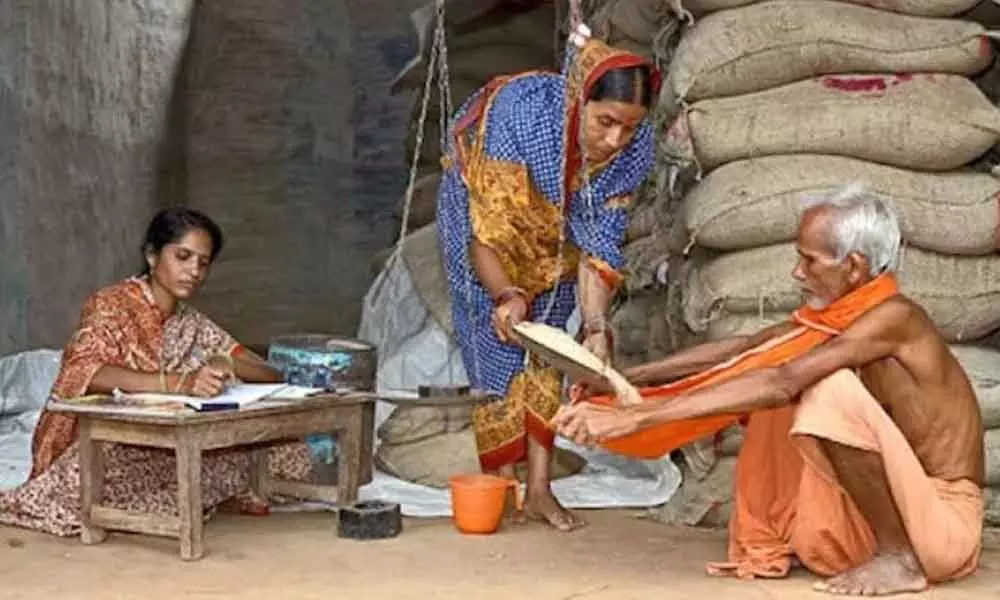PMGKAY played key role in pandemic year

It helped keep extreme poverty at lowest level in 2020, says IMF
The Pradhan Mantri Garib Kalyan Yojana (PMGKAY), which provides free food grains to poor people, played a key role in keeping extreme poverty in India at the lowest level of 0.8 per cent during the pandemic-hit 2020, according to a working paper of the International Monetary Fund (IMF).
The working paper titled 'Pandemic, Poverty, and Inequality: Evidence from India' presents estimates of poverty [extreme poverty PPP$1.9 and PPP$3.2] and consumption inequality in India for each of the years 2004-5 through the pandemic year 2020-21. These estimates include, for the first time, the effect of in-kind food subsides on poverty and inequality. Extreme poverty was as low as 0.8 per cent in the pre-pandemic year 2019, and food transfers were instrumental in ensuring that it remained at that low level in pandemic year 2020. Post-food subsidy inequality at .294 is now very close to its lowest level 0.284 observed in 1993/94.
The PMGKY scheme announced on March 26, 2020 during the pandemic aims to feed the poorest citizens of India by providing grain through the public distribution system (PDS), to all the priority households (ration card holders and those identified by the Antyodaya Anna Yojana scheme). It provides 5 kg of rice or wheat (according to regional dietary preferences) per person and 1 kg of dal to each family holding a ration card for free every month. The scale of this welfare scheme makes it the largest food security program in the world. The additional free grain is over and above the normal quota provided under the National Food Security Act (NFSA) at a highly subsidised rate of Rs 2-3 per kilogram. PMGKAY has been extended till September 2022. The working paper, prepared by Surjit S Bhalla, Karan Bhasin and Arvind Virmani, said that in the pandemic year 2020-21, extreme poverty was at its lowest level ever at 0.8 per cent of the population. "Further, as early as 2016-17, extreme poverty had reached a low 2 per cent level. According to the more appropriate but 68 per cent higher Low Middle Income (LMI) poverty line of PPP (purchasing power parity) USD 3.2 a day, poverty in India registered 14.8 per cent in the pre-pandemic year 2019-20. "This achievement is put in perspective by noting that in 2011-12, the official poverty level for the lower PPP USD 1.9 line was 12.2 per cent," it noted.
The working paper also said that for the first time in several decades, extreme poverty – those falling below the USD 1.9 per person per day in terms of purchasing power parity – in the world increased in the pandemic year 2020. As per the working paper, the pandemic support measures instituted by the government were critical in preventing any increase in the prevalence of extreme poverty and that food subsidies have reduced poverty on a consistent basis since the enactment of the FSA in 2013 and the co-incidental increase in the efficiency of targeting via Aadhaar. Further, it said the effect of the subsidy adjustments on poverty is striking.
"Real inequality, as measured by the Gini coefficient, has declined to near its lowest level reached in the last forty years – it was 0.284 in 1993-94 and in 2020-21 it reached 0.292. "Possibly the more surprising result from the incorporation of food subsidies into the calculation of poverty is that extreme poverty has stayed below (or equal to) 1 per cent for the last three years," it said. Post-food subsidy inequality at 0.294 is now very close to its lowest level of 0.284 observed in 1993-94, the working paper said, adding that in 2020, for the first time since the inception of the PDS system, the government was supplying, in full, the basic food ration needed to the bottom two-thirds of the population. The food support (rations) was increased during the pandemic - the food grain ration was doubled for each recipient from 5 kg of wheat (or rice) per month to 10 kilograms in 2020, it added. (PTI)







